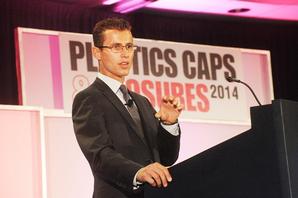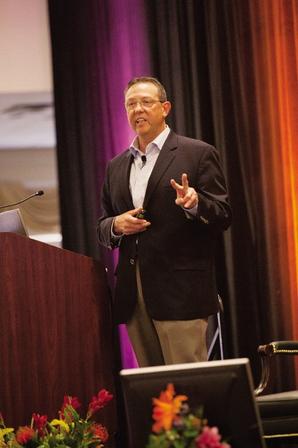By Frank Esposito
SENIOR STAFF REPORTER
Published: November 18, 2014 11:52 am ET
Updated: November 18, 2014 12:09 pm ET

Image By: Michael A. Marcotte
John Hart of P&M Corporate Finance
Plastics firms and outside investors with money to spend increasingly have done so in the plastics industry for the last quarter-century — and private equity firms have played a big role in this 25-year surge.
As recently as the 2000-04 period, the global plastics market averaged only 139 deals per year. By comparison, the most recent five-year period — 2009-13 — saw an average of 358 deals per year in the sector, according to data from P&M Corporate Finance in Southfield, Mich. It’s like the market went from running on a wheezing steam engine to high-powered rocket fuel.
“The last 10 years have been consistent at those high levels,” said P&M plastics and packaging managing director John Hart. “And the number of private equity deals definitely has increased. There were only 74 [PE deals] in 2006, but now there are well over 100 every year.”
As a percentage, private equity buyers or similar financial firms have made up at least 32 percent of global M&A deals nine time in the last 10 years (2004-13), according to P&M. PE’s share of global plastics M&A peaked in 2009 at more than 41 percent.
From the private equity side of the coin, plastics veteran Mike Huff said that PE firms “are looking for different business types and market sectors, and plastics comes up as an attractive growth area.”
“There are opportunities for consolidation, and that’s been the case with Citadel,” added Huff, who’s CEO of compounding firm Citadel Plastic Holdings Inc. “There are opportunities for consolidation and bolt-on acquisitions in plastics. The long-term trend is for plastics — because of light-weighting — to grow in excess of GDP, and we expect that to continue.
“There’s a lot of potential to build out a platform with attractive assets,” Huff said.
West Chicago, Ill.-based Citadel has made seven acquisitions since being founded in 2007 by private equity firm Wind Point Partners. In 2012, Chicago-based Wind Point sold Citadel to another private equity firm — HGGC of Palo Alto, Calif. Citadel most recently bought compounder Lucent Polymers of Evansville, Ind., in early 2014 and now has annual sales of about $400 million.
Plastics M&A veteran Bill Ridenour compared PE firms to the leveraged buyout firms (LBO) of the 1980s and 1990s. But he explained that the PE firms of today have advantages that their LBO predecessors never had.
“LBO firms often didn’t have pools of capital,” said Ridenour, president of Polymer Transaction Advisors Inc. in Newbury, Ohio. “They had to solicit capital and go to bank for financing. And that took longer and made them slower to bid on manufacturing assets than strategic buyers.
“Now they have huge pools of private equity in some cases so they don’t have to wait,” he added. “They have more capital available and can act quickly. They can change to become hybrid buyers, so they can continue to grow the business and grow its core expertise.”

Image By: Blaige & Co.
Thomas Blaige
Market veteran Thomas Blaige said there were other factors outside of private equity that prompted the rise in plastics deal volume.
“If you could sit there in 1989 and look at 2014, you wouldn’t be surprised at all that there was more deal volume, because [plastics] was a growing
industry,” said Blaige, CEO and chairman of Blaige & Co. in Chicago. “What’s been shocking is resin price inflation and globalization.”
Technology also affected the speed of deal-making in 1989, Blaige recalled.
“There was no email, no Internet. To get deals done, you had to send a letter or call someone to talk about it. If you wanted to talk to Mitsubishi, you had send a fax to Tokyo,” he said.
Ultimately, Blaige said that the changing nature of plastics firms’ customers “necessitated deals, as processors and suppliers had to become global just like their customers had. Private equity was part of the oil on the wheel, because these companies had to serve big customers.”
Molding dealmaker Terry Minnick agreed that customer evolution played a role in the sharp increase in plastics M&A deal volume.
“In the 1970s, if you were a good molder, you didn’t need a sales force, because customers found their way to your door,” said Minnick, owner of Molding Business Systems in Florence, Mass. “But with shrinking profit margins and an increased demand for services, it became difficult to grow your business organically. It became cheaper, easier and faster to buy somebody.”
Private equity then became a factor because of its access to mezzanine financing.
“If a $10 million guy wanted to buy a $5 million guy, he could get some funding from his equity, but then private equity would allow him to borrow more to get the deal done,” Minnick said. “In general, private equity has had a very positive impact on the market.”
Higher prices
The rise of private equity also created higher selling prices for many plastics firms by increasing the number of competitors for assets once they hit the market. This might have been a good thing if you were a business owner trying to sell your company after 30 years of hard work, but it wasn’t always welcome news to competitors who were trying to drive up their own profit by consolidating the market.
“In any process, if you have more players in the game, that will drive up [earnings] multiples,” said Huff at Citadel. “Access to capital and availability of low cost capital has a lot to do with it also.
“Now, we’re at the high end of the cycle, and we see that when we’re involved in a deal, there’s a mix of strategic and financial sponsors,” added Huff, whose plastics experience includes a 21-year stint at materials maker GE Plastics. “Sometimes it will be a case where an owner started and built the business to a certain size and is looking look to retirement, but he doesn’t have a succession plan. We see a lot of that.”
This impact can be seen in valuation trends of publicly traded plastics firms, according to P&M. Those valuations, based on earnings multiples, bottomed out at 6.5 during the recession in 2009, but have rebounded to 9.4 this year — a 25-year high and well above the 7.7 average over that time frame. MBS’ Minnick estimated that multiples paid for small to mid-sized plastics firms have increased from 4 to 5.5 in recent years as well.
Ridenour agreed that PE buyers have boosted sale prices for plastics firms.
“Now, [PE firms] act more like strategic firms. A buyer looking to sell used to go to other plastic companies first, but now that’s not always the case,” Ridenour said. “There’s also been a shift in investment interest from highly cyclical markets into non-cyclicals — areas where people buy in a good or bad economy.”
But Blaige contends that growth in the size of deals hasn’t been a good thing for all sectors of the plastics field.
“The average plastics company still only has annual sales of about $30 million, and financing for smaller deals just isn’t available as much now,” he said. “Banks want big deals, not add-ons. Consolidation has left companies with sales of $1 million to $5 million in shambles.
“Millions are available to a company like Berry [Plastics], but not to smaller firms,” Blaige added. “I mean, a company like Sigma [Plastics Group] started out with a small $3 million loan.
“The absence of financing for the lower middle market has reduced the amount of entrepreneurs and startups in plastics, and the lack of entrepreneurs really bothers me,” he said. “People are overlooking that. You don’t hear as many stories anymore of executives getting back into
plastics once they’re out.”
Selling for a profit

Image By: Plastics News
Citadel CEO Michael Huff
The other element that private equity has added to the plastics M&A field is time, since financial investors typically have a defined amount of time that they want to own assets for, before selling them for a profit.
Citadel’s Huff is open about this factor, saying that “time is part of our business model.”
“We have a 5-to-6 year business plan for our investment cycle, and we’re in our second cycle now,” he explained. “That means we have to be specific and nail every deal. We don’t have the latitude to have one that doesn’t perform.
“One of the things you learn is that culture is very important and that you need to have a solid integration plan,” Huff said. “You need to have specific goals for functional teams and to follow your playbook. You don’t want to disrupt customer interface, so it’s important to take into account the cultures of the two businesses you’re trying to put together.”
Ridenour said that kind of timetable is a way of life for private equity firms.
“If you look at the private equity group, they’re looking to a 3-to-7 year window to buy, build, grow and harvest the business,” he said. “That’s still the end game. There will be a flurry of activity in business and the pace in any firm is going to be faster.”
In reviewing the last 25 years of plastics M&A, some deals were mentioned repeatedly, either for their sheer size or for other unique features. As is often the case, some of the biggest flameouts were the most memorable. The list included:
Atlantis Plastics Inc.
The packaging firm that grew through acquisitions between 1986 and 1994 to a peak of 15 plants and annual sales of more than $400 million. A crowded film market led to a bankruptcy filing in 2008, which listed assets of less than $210 million but debts of more than $250 million. Atlanta-based Atlantis eventually sold its films unit to AEP Industries Inc. and its molded products unit to private equity firm Monomoy Capital Partners LP. Monomoy merged the molding operations with Legget & Platt Inc. to form Fortis Plastics LLC, which lasted only three years before closing its doors for good in 2011.
Berry Plastics Group Inc.
Evansville, Ind.-based Berry in 1997 was a regional packaging firm with sales of less than $60 million. Fueled by private equity investors, Berry has made 30 acquisitions since then, posting sales of more than $4.7 billion in 2013. Berry now ranks as North America’s third-largest injection molder, fifth-largest thermoformer and eighth-largest film and sheet maker, according to recentPlastics News rankings.
Engineered Plastic Components Inc.
EPC, an automotive injection molder and blow molder based in Grinnell, Iowa, has made 16 acquisitions since its founding in 1994. Led by owner and CEO Reza Kargarzadeh, the firm made five deals in 2011 alone. The firm now has annual sales of more than $250 million and ranks in the Top 50 of both injection molders and blow molders in the region.
Graham Group
Newtown Square, Pa.-based Graham Group has been involved in more than 60 deals since 1988 — both buying and selling. Its current assets include machinery firm Graham Engineering and packaging firms Convergence Packaging and Comar. Graham Packaging is North America’s second-largest blow molder with annual sales of more than $2.6 billion. Graham Group joined with private equity firm Apollo Management to buy Berry in 2006, and then took Berry public in late 2013.
M.A. Hanna Co.
Starting in the mid-1980s, Hanna, a Cleveland mining firm that traced its history to the 1840s, began to transition into plastics, and by the mid-90s had made more than two dozen acquisitions in plastics and rubber. But integration problems already were showing up by 2000 when Hanna merged with Geon Co., another Cleveland-area firm that ranked as North America’s largest PVC compounder, to form PolyOne Corp. Ongoing problems then caused PolyOne to lose almost $300 million in its first five years of operation. The firm also closed more than 20 plants and cut more than 1,300 jobs. The recession of 2007-08 sent PolyOne down even further before new CEO Stephen Newlin and his management led the company on a remarkable comeback.
Pliant Corp.
The former Huntsman Packaging Corp. business was bought by financial giant JPMorgan & Co. in 2000 and set up shop in Schaumburg, Ill. But, like Atlantis, it struggled in a crowded film market, filing for bankruptcy in 2006 and then for a final time in 2009, when it listed assets of less than $700 million and debt of more than $1 billion. At that time, Pliant had annual sales of $1.1 billion, 18 plants and almost 3,000 employees. It was bought in 2009 by Berry. Private equity firm Apollo had ownership stakes in both firms.
Royal Group Technologies Ltd.
Materials maker Georgia Gulf, a leading PVC resin maker and compounder, paid $1.6 billion in 2006 for PVC building products maker Royal just before the North American housing sector fell from more than 2 million new units per year to less than 500,000. Almost every sector of Woodbridge, Ontario-based Royal, which had been built by Italian immigrant Vic DeZen, was exposed to the housing market. Market conditions soon led Atlanta-based Georgia Gulf to sell off or close a slew of Royal businesses and plants as well as close some of its own PVC operations. The firm lost $250 million in 2008 alone before recovering enough that it could merge with the commodity chemicals business of PPG Industries in 2012 to form Axiall Corp.
Sigma Plastics Group
Lyndhurst, N.J.-based Sigma has made six packaging-related acquisitions since 2009, most recently buying most of the assets of Excelsior Packaging Group in February. Sigma ranks as North America’s second-largest film and sheet maker, with sales of $2.65 billion in 2013.
Spartech Corp.
Clayton, Mo.-based Spartech became a leading plastic sheet maker and a top 30 maker of compounds and concentrates by making 14 acquisitions between 1993 and 2000. But integration problems arose, leading to losses of almost $300 million between 2006 and 2008. Spartech also closed a dozen plants in North America and Europe and eliminated more than 700 jobs from 2008-10. PolyOne then snapped up the struggling firm in late 2012 for less than $400 million. PolyOne closed six Spartech plants in mid-2013.
TriEnda LLC
This deal ended badly for this Portage, Wis.-based thermoformer, which at its peak had sales of more than $100 million. Thermoforming veteran Curt Zamec bought the TriEnda business in late 2007 from Wilbert Inc., a thermoformer where he had been president and CEO since 1999. Shortly after buying TriEnda, Zamec sold a 36 percent stake in the firm to Neil and Don Kruschke, brothers who owned Ohio-based plastics machinery firms. In early 2009, TriEnda opened a new, $20 million plant, but things soon went south. Dutch container firm SAS soon was making up a staggering 85 percent of TriEnda’s sales, which damaged TriEnda when SAS cancelled orders and refused to pay more than $10 million in invoices. TriEnda, which as recently as 2010 ranked as North America’s 15th-largest thermoformer, eventually sold its assets amid a flurry of lawsuits between Zamec and the Kruschke brothers. (Neil Kruschke died in 2011.)
Deal reactions
Private equity was involved in several of these deals. The list in general drew a range of reactions from plastics financial pros. The fact that six of the 10 deals on the lists were disappointments says more about “general business execution,” than about the plastics market, according to Hart at P&M.
“They put a number together, and sometimes it works out, but sometimes it doesn’t,” he said. “When companies become part of a large corporation, they sometimes lose customer service — but some can keep it and become successful.”
“Pliant didn’t work out and TriEnda blew up,” said Blaige. “In some of these cases, people overpaid. Spartech in particular overbid on some of its acquisitions. Some of these companies also had problems with post-merger integration.”
“Some of these deals were good and the companies have grown,” said Minnick at MBS. “But some were bought by people that didn’t understand the business and they then brought in people from outside the business who didn’t understand it either.”
Outside of private equity, P&M’s Hart cited a sustained period of lower-cost debt and baby boomer entrepeneurs reaching retirement age as reasons for M&A growth in the last decade. Distressed sales caused by the recession, as well as the creation of stronger survivors from this period, also played a role, he said.
Going forward, PTA’s Ridenour said that he expects to see “the same mix of buyers — well-financed private equity groups in direct competition with strategic buyers for assets.”
And it doesn’t sound like Citadel’s Huff, a resident of the private equity world, expects the M&A ride to end anytime soon.
“We have to be strategically aligned with our sponsors, so when an [acquisition] opportunity comes up, we don’t have to debate,” he said. “We have a good team on our leadership group with a lot of industry experience. And we’ve got growth capital that can support organic growth and add production capacity.”
| 